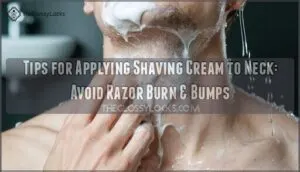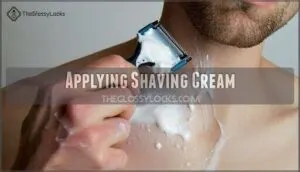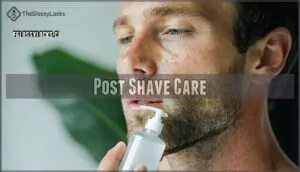This site is supported by our readers. We may earn a commission, at no cost to you, if you purchase through links.

The neck’s curves require extra attention – don’t rush this step. Apply cream in an upward motion against hair growth to lift follicles properly.
Build a rich lather that cushions your razor and prevents irritation. Your neck skin is thinner than your face, so gentle pressure is key.
The right application technique transforms your shave from a daily chore into smooth sailing. Mastering pressure and stroke direction makes all the difference.
Table Of Contents
- Key Takeaways
- Choosing Shaving Cream
- Applying Shaving Cream
- Lathering Neck Area
- Shaving Cream Types
- Pre-Shave Routine
- Shaving Cream Application
- Shaving Techniques
- Post-Shave Care
- Common Mistakes
- Optimizing Shave Experience
- Frequently Asked Questions (FAQs)
- What’s the proper way to shave your neck?
- What is the 3:1:1 rule for shaving cream?
- Should you shave upwards on your neck?
- Do I need a brush to apply shaving cream?
- How do I Shave my Neck If I have sensitive skin?
- How do you treat a razor bump in women?
- How to avoid irritation when shaving your neck?
- How to shave a smooth neck?
- Are you supposed to shave up or down on your neck?
- What is the 3 1 1 rule for shaving cream?
- Conclusion
Key Takeaways
- Always start with warm water to soften your neck hair and open pores before applying shaving cream.
- Use circular, upward motions to build a rich lather and ensure complete coverage, lifting hair for a smoother shave.
- Pick a sensitive skin shaving cream made for sensitive skin or fragrance-free to minimize irritation on your neck.
- Shave with gentle pressure and follow your hair’s natural growth direction to prevent razor burn and bumps.
Choosing Shaving Cream
You’ll find the right shaving cream makes all the difference between a smooth neck shave and angry red bumps that’ll have you looking like you wrestled with a porcupine.
Look for creams labeled "for sensitive skin" or fragrance-free options, since your neck’s delicate skin needs gentler ingredients than the tougher whiskers on your face can handle.
Sensitive Skin Options
When dealing with sensitive skin, your neck deserves the gentlest shaving cream application possible.
Sensitive products create a protective barrier that prevents skin irritation during neck shaving, while calming gels provide superior lubrication for delicate areas.
Understanding your skin type matters is vital for selecting the right products.
- Gel-based formulations – Offer enhanced protection and reduce razor burn risk
- Almond oil-based creams – Minimize inflammation while providing smooth glide
- Dermatologist-recommended formulas – Guarantee gentle care for reactive skin types
Fragrance-Free Creams
Three out of four men experience neck irritation from fragranced products during shaving.
Fragrance-free shaving creams eliminate this common trigger, making them essential for sensitive skin.
These gentle formulas focus on protection without unnecessary additives that cause redness or bumps.
When applying fragrance-free cream to your neck, you’re choosing hypoallergenic options that prioritize comfort over scent.
Natural Ingredients
Natural shaving cream ingredients can transform your neck shaving experience.
Look for products containing Aloe Vera, which soothes irritated skin, or Tea Tree oil that fights bacteria.
Coconut Oil provides excellent lubrication, while herbal extracts offer gentle protection.
These preshave products work especially well for sensitive skin, delivering shaving cream benefits without harsh chemicals that trigger razor burn.
Applying Shaving Cream
Once you’ve selected the right shaving cream, proper application becomes essential for protecting your neck’s sensitive skin from razor burn and irritation.
You’ll want to use circular motions to create an even layer that lifts hair follicles and provides maximum cushioning against your razor’s blade.
Circular Motions
Work up your shaving cream using circular motions to create that perfect soft lather.
These circular strokes lift hair follicles while building rich foam that’ll give you smooth glide during neck shaving.
Apply gentle touch as you massage – this technique guarantees better coverage than straight lines.
Your shaving techniques improve dramatically when you master these fundamental shaving tips for superior results, and by using circular motions you can achieve a smoother shave.
Even Coverage
Your cream application success depends on complete lather distribution across every inch of neck skin.
Don’t leave patches bare—they’ll turn into razor burn hotspots faster than you can say "ouch."
Work methodically from jawline to collar, ensuring your shaving cream types provide uniform coverage.
These coverage tips prevent missed spots that create uneven shave patterns during your smooth shave routine.
Lifting Hair Follicles
Proper application creates hair lift that transforms your shave prep routine.
When you work shaving cream into your neck using upward circular motions, you’re creating skin tension that makes stubborn follicles stand at attention.
- Massage upward – Lift hair against natural growth patterns
- Create friction – Build rich lather while raising follicles
- Focus on problem areas – Target spots prone to skin irritation
- Maintain gentle pressure – Avoid aggressive rubbing
Lathering Neck Area
You’ll want to work up a rich, thick lather on your neck area using circular motions to help the shaving cream soften your hair and provide maximum protection.
Starting with the neck area first gives the cream extra time to work while you prepare other areas, creating the cushioning your sensitive neck skin needs.
Warm Water Preparation
Start your preshave routine by splashing warm water on your neck for 2-3 minutes.
This simple step softens hair follicles and opens pores, creating the perfect foundation for shaving cream application.
The warmth prepares your skin for smoother razor glide during neck shaving.
| Water Temperature | Effect on Skin |
|---|---|
| Cold (60-70°F) | Tightens pores, hardens hair |
| Lukewarm (80-90°F) | Minimal skin softening |
| Warm (100-110°F) | Opens pores, softens follicles |
| Hot (120°F+) | Causes irritation, redness |
| Room temp (70-75°F) | No preparation benefit |
Rich Lather Benefits
Building rich lather creates a protective cushion that transforms your neck shaving experience.
Quality lather thickness provides essential skin protection while enhancing shave comfort through improved razor glide.
This dense foam acts like a shield, reducing friction and preventing nicks.
Your shaving cream works harder when properly lathered, delivering the smooth shave you’re after with substantially less irritation.
Using the right shaving foam products can make a big difference in achieving the perfect shave.
Softening Hair
Warm water acts like a hair softener, opening hair follicles and making stubble pliable before you apply shaving cream.
This softening process helps your razor glide smoothly with gentle strokes, reducing tugging that causes irritation.
Soothing gels work best on pre-softened hair, creating ideal shaving lubrication that respects your hair growth direction and protects sensitive neck skin, ensuring a smooth experience with gentle strokes.
Shaving Cream Types
You’ll find three main types of shaving cream designed to protect your neck’s sensitive skin during your morning routine.
Gel-based creams provide clear visibility and precise application, foam-based options offer quick coverage with built-in lather.
Oil-based creams create a protective barrier that’s perfect for preventing razor burn on delicate neck areas.
Gel-Based Creams
Gel-based creams offer superior skin protection through their unique cream texture that clings to your neck’s contours.
These shaving products create excellent lather formation while providing enhanced lubrication compared to traditional options.
The use of Gel Shaving products can greatly improve shaving results.
Here are five gel benefits for neck shaving:
- Enhanced Lubrication – Reduces friction during razor passes
- Better Visibility – Clear formulas let you see hair patterns
- Moisture Retention – Prevents skin from drying out mid-shave
- Improved Glide – Smoother razor movement across sensitive areas
- Longer Lasting – Stays active throughout your entire shaving routine
Foam-Based Creams
Foam-based creams offer instant lather formation without water, making them perfect for quick neck shaving sessions.
The pre-whipped foam texture provides immediate coverage and cushioning for your razor. These shaving products work best when you apply thin, even layers across your neck area.
While convenient, foam benefits include easy application and mess-free storage, though they may not provide the richest lather formation compared to traditional creams.
Oil-Based Creams
Oil-based shaving creams offer superior skin protection through natural lubrication that creates a protective barrier between your razor and neck.
These formulas deliver enhanced moisture levels while producing a rich lather texture that lifts hair follicles effectively.
Unlike traditional options, oil types like coconut and almond provide lasting cream benefits, making your neck shaving routine gentler and more comfortable.
Pre-Shave Routine
Before you apply shaving cream to your neck, you’ll want to prepare your skin properly to reduce irritation by up to 70%.
Start with warm water or a towel to soften hair and open pores, then consider adding pre-shave oil for extra protection against razor burn.
Exfoliating Skin
Gentle exfoliation removes dead skin cells that can trap hairs and cause ingrown bumps on your neck.
Use a mild scrub or exfoliating brush twice weekly, focusing on circular motions to enhance pore cleansing without irritating sensitive skin types.
This facial massage technique prepares your neck for smoother shaving by clearing debris and improving razor glide across freshly cleaned skin.
Pre-Shave Oils
After exfoliating, you’ll want to create a protective barrier before applying shaving cream.
Preshave oil delivers significant oil benefits by softening hair and improving razor glide across your neck’s sensitive skin.
This skin prep step reduces neck irritation by 70% and enhances your shaving frequency comfort.
The oil works with shaving cream to maximize irritation reduction through proper hair softening preparation.
Warm Towel Application
After applying pre-shave oil, grab a warm towel for the next step in your neck preparation routine.
This warm compress technique helps open hair follicles and achieve ideal skin softening before applying shaving cream.
The proper towel temperature creates an ideal foundation for your shaving technique while reducing neck irritation.
Using a consistent pre shave routine is vital for avoiding razor burn and ingrown hairs.
- Steam rising from a freshly heated towel wrapped around your neck
- Hair follicles relaxing and opening under gentle warmth
- Stubborn whiskers softening like butter on warm toast
Shaving Cream Application
Applying shaving cream correctly to your neck makes the difference between a smooth shave and an irritated mess that’ll have you looking like you wrestled with a cheese grater.
You’ll want to use upward circular motions to lift those stubborn neck hairs while ensuring complete coverage from your jawline down to your collar, because missing spots means razor burn in those exact areas, leading to an irritated mess that can be avoided with proper technique to achieve a good shave.
Upward Motion
When applying shaving cream with upward strokes, you’ll achieve superior hair lift that makes each follicle stand at the ideal angle.
This upward motion creates necessary skin tension while stretching your neck area for better razor glide.
The technique guarantees your shaving cream works deeper into hair roots, following proper shaving direction for effective neck care and improved shaving technique results.
Coverage Area
After working your way up with upward motions, you’ll need to map out your neck’s unique landscape.
Different skin types and hair density require adjusted coverage techniques across various shave zones.
Your neck contours aren’t uniform—some areas need thicker application while others require lighter coverage.
This neck shaving guide guarantees every spot gets proper shaving cream protection for superior neck care.
To achieve a smooth shave, consider the importance of using the right sensitive scalp techniques to minimize irritation.
Avoiding Clogged Pores
Your skin’s natural oils can trap debris and create clogged pores during neck shaving if you’re not careful.
Rinse thoroughly with warm water before applying shaving cream to remove buildup.
Use gentle circular motions for proper pore cleansing and skin exfoliation around each hair follicle.
This clog prevention technique guarantees better pore minimization and smoother shaving results.
Shaving Techniques
Once you’ve applied your shaving cream properly, the actual shaving technique makes the difference between a smooth result and an irritated, bumpy neck.
You’ll want to use short, controlled strokes with minimal pressure while shaving in the direction your hair grows to prevent razor burn and ingrown hairs.
Short Strokes
Short strokes give you better control over your shaving technique when tackling that tricky neck area.
Keep each stroke about one to two inches long – think precision over speed.
This stroke length helps you maintain proper razor angle and skin tension while maneuvering curves around your Adam’s apple.
Short movements reduce shaving irritation and let you adjust your approach as needed, which is crucial for achieving a smooth shave with proper razor angle.
Gentle Pressure
Feather-light touches work wonders when shaving your neck.
Let the razor’s weight do the heavy lifting—you’re just guiding it along.
Apply minimal pressure with gentle strokes for a smooth glide that prevents razor burn.
Think of it like painting delicate watercolors rather than scrubbing dishes, using a soft touch technique that reduces irritation while delivering effective neck shaving results.
Shaving With Grain
After applying gentle pressure, you’ll want to follow your hair’s natural direction. Shaving with grain prevents irritation and reduces razor burn substantially.
Map your neck’s hair growth patterns before starting—this simple step transforms your shaving technique. Understanding proper beard shaving techniques is essential for a smooth shave.
Here’s your grain-following game plan:
- Identify hair direction using circular finger motions
- Start with downward strokes on most neck areas
- Adjust angles around your Adam’s apple
- Use short, controlled movements for better precision
- Maintain consistent direction throughout each pass
Post-Shave Care
Your post-shave routine determines whether you’ll walk away with smooth, comfortable skin or spend the next few hours dealing with irritation and razor burn.
Proper aftercare with cool water, soothing balm, and moisturizer helps close your pores and protects your freshly shaved neck from developing bumps or redness, which is crucial for achieving smooth skin.
Cool Water Rinse
After your neck shaving technique, splash cold water on your freshly shaved skin.
This temperature shock triggers pore closure and provides immediate skin soothing through cold therapy.
The cool rinse acts like nature’s anti-inflammatory, reducing irritation and calming razor burn.
This simple step transforms your shaving experience from potentially uncomfortable to invigoratingly smooth, especially for those with skin sensitivity.
Aftershave Balm
After rinsing with cool water, aftershave balm becomes your neck’s best friend for soothing skin and reducing irritation. This powerhouse product offers multiple balm benefits that promote skin healing through its antiseptic properties and calming effects.
Apply aftershave balm with these essential aftershave tips:
- Pat gently onto completely dry skin rather than rubbing vigorously
- Cover entire shaved area including jawline and neck curves
- Choose alcohol-based formulas for antiseptic protection and quick absorption
- Look for witch hazel ingredients that naturally reduce redness and inflammation
- Allow full absorption before touching your face to prevent contamination
The 40-60% alcohol content in quality aftershave balm provides vital antiseptic benefits while active ingredients like panthenol deliver immediate relief from shaving irritation reduction. When selecting your postshave care routine, remember that aftershave balm works differently than moisturizers—it tones skin, reduces blood flow to prevent inflammation, and creates a protective barrier that helps your neck recover from the shaving process. Using a post shave balm can substantially enhance the skin’s natural recovery process after shaving.
Moisturizing Skin
After using aftershave balm, your skin needs proper hydration to maintain its moisture balance.
Apply an unscented moisturizer within minutes of shaving to lock in hydration and prevent dry skin.
This final step in your postshave care routine helps sensitive skin recover from the shaving process.
| Moisturizer Type | Best For | Application Time |
|---|---|---|
| Unscented Lotion | Sensitive Care | Within 2 minutes |
| Aloe-Based Gel | Irritated Skin | Immediately after |
| Hypoallergenic Cream | Dry Skin | After aftershave balm |
Common Mistakes
Even experienced shavers often make basic errors when applying cream to their neck that lead to irritation and poor results.
Skip the fancy technique—most neck irritation comes from rushing through cream application like you’re buttering toast.
You’re likely rushing the process, using too little product, or applying it incorrectly without realizing these mistakes cause most razor burn problems, which can be attributed to the fact that you’re likely making these errors.
Insufficient Lather
Skimping on lather thickness creates a recipe for disaster when neck shaving.
You need rich, cushioning foam that protects your sensitive skin from razor drag.
Thin, watery shaving cream won’t cut it—literally.
Poor lather distribution leaves vulnerable spots exposed to irritation.
Focus on building quality foam through proper cream application and shave preparation.
Your neck deserves better than insufficient lather protection.
Incorrect Application
Many shaving cream errors stem from poor application technique rather than product quality.
You’re creating lather issues when you apply cream in random directions or skip areas entirely. These application mistakes during shave prep can cause serious skin damage.
Always work shaving cream into your neck using upward circular motions, ensuring complete coverage before attempting any shaving technique to prevent razor bumps and achieve a smooth shave with proper lather.
Rushing Shave Process
Time is the enemy of smooth neck shaving.
Your hasty application of shaving cream won’t provide adequate protection, leading to razor burn and bumps.
Quick lather that looks good enough rarely softens hair properly, and fast strokes during shave prep compromise your shaving routine’s effectiveness.
Slow down your shaving technique, reduce razor pressure, and let the cream work its magic for better results.
Optimizing Shave Experience
You can transform your daily shave from a dreaded chore into a smooth, comfortable experience by fine-tuning three key elements: how often you shave, when you change your blade, and how well you prepare your skin.
Getting these basics right means you’ll spend less time dealing with razor burn and more time enjoying that fresh, clean feeling.
Shaving Frequency
Your shaving frequency directly impacts neck irritation levels.
Daily shave enthusiasts often experience more razor burn than those following weekly routines.
Most men benefit from shave intervals of 2-3 days, allowing hair regrowth time while preventing excessive length.
Tailor your shave schedules to your skin’s recovery needs.
Those with sensitive necks should avoid daily shaving, opting for gentler neck shaving routines instead.
Understanding the essential shaving frequency guidelines is vital for minimizing razor burn and achieving a smoother shave.
Blade Sharpness
Sharp razor blades make all the difference between a smooth shave and an irritating experience.
A dull blade edge requires more pressure and multiple shaving strokes, increasing your risk of razor burn on sensitive neck skin.
Here’s how to maintain ideal razor sharpness:
- Perform regular sharpness tests – If your razor tugs or pulls at hair instead of cutting cleanly, it’s time for blade replacement
- Monitor edge durability – Most cartridge blades last 5-7 shaves, while safety razor blades need changing every 3-5 uses
- Check your shaving angle – A proper 30-degree blade angle maximizes cutting efficiency and extends blade life through effective razor maintenance
Skin Preparation
Before neck shaving, proper skin preparation sets the foundation for success.
Start with facial steaming or a warm compress to open pores and soften stubble.
Gentle exfoliation methods remove dead skin cells, especially around sensitive areas.
Understanding your skin types helps choose appropriate products.
This groundwork guarantees your shaving cream works effectively, preventing razor burn and creating smoother results.
Frequently Asked Questions (FAQs)
What’s the proper way to shave your neck?
Proper skin preparation reduces razor burn risk by 70%.
Start with warm water to soften hair, apply pre-shave oil, then shave with the grain using short strokes and minimal pressure for irritation-free results.
What is the 3:1:1 rule for shaving cream?
This specific ratio isn’t a recognized standard in traditional grooming practices.
You’ll find better results focusing on even cream distribution using circular motions and ensuring adequate coverage for protection rather than following numerical formulas.
Should you shave upwards on your neck?
Don’t shave upwards on your neck initially.
Always start by shaving with the grain to minimize irritation.
Once your skin adapts after several days without redness, you can carefully try against-the-grain techniques.
Do I need a brush to apply shaving cream?
About 60% of men skip using brushes entirely.
You don’t need one – your hands work perfectly fine for applying shaving cream to your neck.
Simply use circular motions to create rich lather that lifts hairs effectively.
How do I Shave my Neck If I have sensitive skin?
Start with warm water to soften hair, then apply pre-shave oil.
Use gentle razors, shave with the grain using short strokes, apply zero pressure.
Finish with cool water and unscented moisturizer.
How do you treat a razor bump in women?
Seventy percent of women experience razor bumps at least once.
You’ll want to apply a cold compress immediately, then use aloe vera gel twice daily.
Don’t pick at bumps—they’ll heal faster with gentle care.
How to avoid irritation when shaving your neck?
Prep your neck with warm water, map your hair’s growth direction.
Use gentle razors with sharp blades, shave with the grain using light pressure.
Finish with cool water and moisturizer.
How to shave a smooth neck?
Nobody wants a neck that feels like sandpaper after shaving.
Prep with warm water, apply quality shaving cream, shave with the grain using short strokes,
then rinse thoroughly.
Then moisturize for baby-smooth results.
Are you supposed to shave up or down on your neck?
You should shave down on your neck, following the hair’s natural growth direction.
This with-the-grain technique minimizes irritation and razor burn.
Once your skin adapts, you can try shaving upward for closer results, using the with-the-grain technique as a basis for comparison.
What is the 3 1 1 rule for shaving cream?
The 3 1 1 rule means using three parts water, one part shaving cream, and one minute to lather.
You’ll get a rich, protective foam that cushions your skin—no need to pile it on like frosting!
Conclusion
Mastering these tips for applying shaving cream to neck will revolutionize your grooming routine beyond your wildest dreams.
You’ll prevent razor burn and bumps by choosing the right cream, preparing your skin properly, and using correct application techniques.
Remember to work in circular motions, build rich lather, and maintain gentle pressure throughout.
Don’t rush the process—your neck’s delicate skin deserves careful attention.
With consistent practice, you’ll achieve smooth, irritation-free shaves every time.
- https://cremocompany.com/blogs/blog/how-to-shave-neck
- https://www.reddit.com/r/wicked_edge/comments/vo07p7/no_matter_what_i_do_my_neck_always_gets_extreme/
- https://www.quora.com/What-are-some-good-shaving-techniques
- https://otisskincare.com/blogs/news/how-to-shave-your-neck?srsltid=AfmBOooRxj6alS_Ilkxc_rVTljXtVa7hI7My5np-S_nIXbwnLKc0MIya
- https://www.nivea.co.uk/advice/men/how-to-shave
















